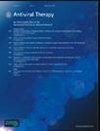新型乙型肝炎病毒衣壳组装调节剂JNJ-64530440单次和多次递增剂量在健康志愿者中的药代动力学、安全性和耐受性
IF 2.3
4区 医学
Q4 INFECTIOUS DISEASES
引用次数: 0
摘要
研究了乙型肝炎病毒衣壳组装调节剂JNJ-64530440在健康志愿者体内的药代动力学和安全性。该I期研究(NCT03439488)是一项双盲、随机、安慰剂对照研究。成人(n = 10/队列,5名亚洲人/ 5名非亚洲人),随机分组为4:1,在禁食(50、150、300和900 mg)或喂养(300、750、1000、2000和4000 mg)条件下接受单次上升剂量的口服JNJ-64530440(第一代和第二代配方)或安慰剂。评估了750或2000 mg每日一次和750 mg每日两次的多次上升剂量JNJ-64530440(第二代制剂),持续7天。根据血浆浓度估计药代动力学参数。安全评估贯穿始终。结果在不同剂量下,最大血浆浓度(Cmax)和血浆浓度-时间曲线下面积(auc)的增加均小于剂量比例。平均血浆半衰期从9.3到14.5小时不等。进食条件下的Cmax和AUC是禁食条件下的2倍,亚洲人略高于白种人。JNJ-64530440剂量≥750 mg的血浆水平高于蛋白结合调整浓度,显示出体外抗病毒活性。未见严重不良事件(ae)、治疗中断或剂量限制性毒性。AE频率/严重程度不随剂量增加而增加。结论:JNJ-64530440单次(最多4000 mg)和多次(最多2000 mg,连续7天)在健康志愿者中耐受性良好。多次剂量≥750mg /天达到预期具有抗病毒活性的血浆浓度,可能降低乙型肝炎表面抗原。亚洲人与白种人在耐受性或药代动力学参数方面未见临床相关差异。本文章由计算机程序翻译,如有差异,请以英文原文为准。
Pharmacokinetics, safety and tolerability of single- and multiple-ascending doses of JNJ-64530440, a novel hepatitis B virus capsid assembly modulator, in healthy volunteers
Background Pharmacokinetics and safety of JNJ-64530440, a hepatitis B virus capsid assembly modulator producing normal empty capsids (CAM-N), in healthy volunteers were evaluated. Methods This Phase I study (NCT03439488) was a double-blind, randomised, placebo-controlled study. Adults (n = 10/cohort, five Asian/five non-Asian), randomised 4:1, received single-ascending doses of oral JNJ-64530440 (first- and second-generation formulations) or placebo under fasted (50, 150, 300 and 900 mg) or fed (300, 750, 1,000, 2000 and 4000 mg) conditions. Multiple-ascending doses of 750 or 2000 mg once daily and 750 mg twice daily JNJ-64530440 (second-generation formulation) for 7 days were evaluated. Pharmacokinetic parameters were estimated from plasma concentrations. Safety was assessed throughout. Results Less than dose-proportional increases in maximum plasma concentrations (Cmax) and area under the plasma concentration–time curves (AUCs) were observed across the doses. Mean plasma half-lives ranged from 9.3 to 14.5 h. Cmax and AUC were ∼two fold higher under fed versus fasting conditions and slightly higher in Asians versus Caucasians. JNJ-64530440 doses ≥750 mg achieved plasma levels higher than protein-binding adjusted concentrations demonstrating in vitro antiviral activity. No serious adverse events (AEs), treatment discontinuations or dose-limiting toxicities were seen. AE frequency/severity did not increase with dose. Conclusions Single (up to 4000 mg) and multiple doses (up to 2000 mg for 7 days) of JNJ-64530440 were well tolerated in healthy volunteers. Multiple doses ≥750 mg/day achieved plasma concentrations expected to have antiviral activity that may lower hepatitis B surface antigen. No clinically relevant differences in tolerability or pharmacokinetic parameters were seen between Asians versus Caucasians.
求助全文
通过发布文献求助,成功后即可免费获取论文全文。
去求助
来源期刊

Antiviral Therapy
医学-病毒学
CiteScore
2.60
自引率
8.30%
发文量
35
审稿时长
4-8 weeks
期刊介绍:
Antiviral Therapy (an official publication of the International Society of Antiviral Research) is an international, peer-reviewed journal devoted to publishing articles on the clinical development and use of antiviral agents and vaccines, and the treatment of all viral diseases. Antiviral Therapy is one of the leading journals in virology and infectious diseases.
The journal is comprehensive, and publishes articles concerning all clinical aspects of antiviral therapy. It features editorials, original research papers, specially commissioned review articles, letters and book reviews. The journal is aimed at physicians and specialists interested in clinical and basic research.
 求助内容:
求助内容: 应助结果提醒方式:
应助结果提醒方式:


